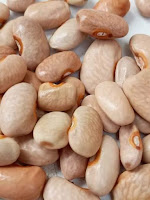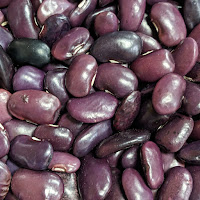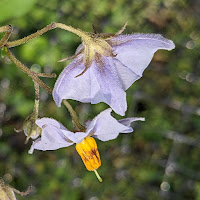After several years of looking for a truly blue dry bean, I started actively working to produce my own variety in 2018 when I was gifted a few bluish-black hybrid seeds from a bean collector. At the end of 2022, I was essentially done. Five years of selecting the best blue seeds each season and my new variety finally produced a consistently blue crop.
There's probably still going to be a few more years of increasing the seed before I'm prepared to distribute them in some fashion. Along the way I'll be selecting for increased productivity and having to figure out where I can grow more of them each year.

Since harvesting the most recent crop, I've been digging into what research literature there is about the genetics and biology of color in beans. This was initially just to get a better idea of what was going on in my beans. Along the way I realized I could probably use the knowledge I had gained to intentionally make new blue varieties.
The initial random hybrid was between a black variety (Haudenosaunee Skunk) and a yellow-tan variety (Arikara Yellow). That color combination would clearly work as parents in a new cross, but I realized there was a combination of parental color genetics that would probably make it easier to recover the right combination of genes to produce a blue color.
The color of black beans is caused by a combination of red, blue, and yellow-brown pigments at high intensity. In Phaseolus vulgaris, a small number of genes lead to this color: R ("red"; likely a transcription factor driving enzyme F3'H), V ("violet"; enzyme F3'5'H), and then B ("brown"; transcription factors enhancing CHS/CHI, darkening all downstream pigments). A yellow-brown bean is caused by all three genes being inactive (written as "rvb"). There are a few other genes that seem to impact exactly what shade of brown color may result, but there doesn't seem to be as much clarity in the research literature about that part of the pigment pathway.
The difference between a purple and a black bean is that the purple bean has an inactive version of B (b). Crossing a purple bean (RVb) to a yellow bean (rvb), where both have the recessive inactive b allele, reduces the genetic possibilities in the F2s to only those impacting the red and blue pigments. Among the F2 plants, we should see the ratios of a dihybrid cross play out. 9 purples, 3 reds, 3 blues, and 1 yellow-brown. 3/16 isn't that bad and I can easily grow enough plants to expect to be able to find the blues I'm looking for.
I wasn't able to find any sign of a purple version of P. acutifolius (tepary) beans. I did find black and yellow versions that I could use with more difficulty. I'll keep looking for a purple version and may eventually decide to try using a black variety instead, but for now I'll hold off on trying to make a blue variety of this species.
The color of a seed is determined by the genes of the mother plant, so it can take some tricks to sort things out. The plan will take a few years to play out.
- 2023 : Plant purple & yellow seeds on a common trellis. Some harvested seeds may be hybrids, but we can't identify them yet. Save them separated by color.
- 2024 : Plant yellow seeds only. Save harvested seeds by color.
- Yellow seeds : mother plant wasn't hybrid.
- Purple seeds : mother plant was a hybrid between purple & yellow plants. These seeds will grow into F2 plants.
- 2025 : Plant purple seeds only. Save harvested seeds by color.
- The F2 plants should fall into four categories (9 purple : 3 red : 3 blue : 1 yellow). I've already determined I can grow F2 plants in a mass planting and observe the expected ratios in the cumulative produced seed counts.
P. coccineus and P. lunatus are strong out-crossers, so I can rely on bees and other pollinators to do the work of transferring pollen for me. The two species can't cross, so I can do both parallel experiments in a relatively small garden space. To increase the odds of the yellow seeds produced in 2023 being hybrids, I can plant many more purple seeds than yellow (or even only one yellow seed among many purple). This will result in most flowers that a yellow-seed plant can cross with being those from purple-seed plants.
If no purple seeds turn up in 2024, then no useful cross-pollinations happened in 2023. In 2025 I would then plant purple and yellow seeds to try and find crosses again. There may be some hybrid seeds among the purples, but distinguishing them from the non-hybrids would take a couple more years and require individual plants to be grown on separate trellises. That's more work than I want to put into it, hence designing the plan the way I have.
This plan assumes the genes driving F3'H (red anthocyanins) and F3'5'H (blue anthocyanins) are unlinked in these species. I know in P. vulgaris the two genes are not tightly linked. If they were, I would not expect to have been able to find the initial blue-seeded plant so easily as I did. That it is possible to make hybrids between P. vulgaris and P. coccineus tells us their genomes are organized in largely the same fashion, so the two genes should be similarly not tightly linked in P. coccineus. Making hybrids with P. lunatus is harder, but still possible, so similarly I don't expect the two genes to be tightly linked.
Why aren't there already blue varieties of these species available? I don't know, but I feel it might be the same reason that blue varieties of P. vulgaris are so very rare, whatever that is. That and the vast majority of people who have ever grown beans have not been geneticists backed up with decades of published research into the biology of bean pigments. In a few years, I hope to have remedied this absence.
- Bean varieties:
- Haudenosaunee Skunk: https://exchange.seedsavers.org/page/variety/id/193592
- Arikara Yellow: https://www.seedsavers.org/arikara-yellow-bean
- Pima Orange : https://www.nativeseeds.org/products/pl011
- Black Tepary : https://www.nativeseeds.org/collections/tepary-beans/products/pt082
- S'oam Baw Tepary : https://www.nativeseeds.org/collections/tepary-beans/products/pt120
- Blog posts:
- https://the-biologist-is-in.blogspot.com/2018/10/the-color-of-beans-1.html
- https://the-biologist-is-in.blogspot.com/2022/12/the-color-of-beans-2.html
- https://the-biologist-is-in.blogspot.com/2023/01/the-color-of-beans-3.html
- https://the-biologist-is-in.blogspot.com/2023/02/the-color-of-beans-4.html
- Bean species hybrds:











